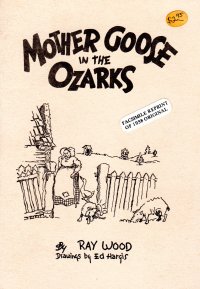 As I accurately predicted on Sunday, I read this book first of the ones I picked up. I have so little time to read these days that monographs and twee little books are about all I can get read in a timely fashion.
As I accurately predicted on Sunday, I read this book first of the ones I picked up. I have so little time to read these days that monographs and twee little books are about all I can get read in a timely fashion.
This book is a 1983 reprint of the 1938 original, a sticker on the cover informs us, and it is an illustrated collection of what might have passed for nursery rhymes in the Ozarks around the turn of the twentieth century. The perface tells us about the author and the history of the rhymes in this collection which later appeared elsewhere (we’ll get to that in a minute). H. L. Mencken had nice words to say about it when it was published.
The little rhymes in it are a bit twee and facile, but I’m coming to them from a position where Mother Goose and the European nursery rhymes are wisdom received at a young age. Perhaps if I were exposed to these rhymes in my youth and Mother Goose as an adult, I’d have the completely opposite reaction. So, some were amusing, but most were just rhymes for children to recite because nobody had television or radios yet.
One thing that modern audiences would zot onto is the use of perjoratives for blacks. A couple of the rhymes involve accusing a black person of something or just denigraating a black person, but that loses a bit of context that a lot of people mentioned in these rhymes are not represented in the best light. The book also disparages Irish people and other individuals. Face it, if you’re in a nursery rhyme, you’re not doing to well. But modern scholars and readers have their own biases and focii, so that’s what they would see first. Not that I’m defending the viewpoint; only that I can read something like it and say, “That’s not right,” where modern arbiters might not let me read it at all because they don’t trust my judgment.
Some things sounded familiar, though, such as:
Chicken in th’ bread-pan
Pickin’ up th’ dough
Granny will your dog bite?
No, child, no.
Where have I heard that before?
Also, this one learned me the source of an expression that was a fabled book and then a major motion picture:
William tremble-toe is a good fisherman
Catches hens–puts them in pens
Some lay eggs–some lay none
Wire, briar, limberlock, three geese in a flock
One flew east, one flew west
One flew over the cuckoo’s nest.
The nursery rhyme listed as the source of the title in Wikipedia differs, though.
Another features a character asking for his jimmy-john. I wondered if he wanted a sandwich, but after a little research which was mainly trying to formulate a search query that would return me something other than information about the restaurant chain, I discovered this probably refers to a whiskey jug.
At any rate, a quick read. A little educational, as it taught me the things I mentioned above. But it would be doubleplus ungoodthink to many who would then not learn what else it might have to teach.


